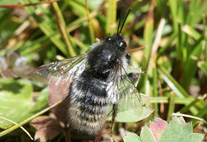Abstract
Bumblebees are important pollinators for wild flowers and agricultural crops. North China is a region of varied geomorphology and vegetation, with plateaus, plains, mountains and deserts, and is part of the greatest hotspot of bumblebee diversity worldwide. We report on a field survey of the bumblebees of North China made between 2005–2012. A sample of 21,636 bumblebee specimens are assigned to 76 species. One older specimen held in London added one more species to this list. Together, these 77 species represent 10 subgenera of the genus Bombus. Seven species are recorded from North China for the first time: B. (St.) distinguendus, B. (Th.) anachoreta, B. (Th.) pseudobaicalensis, B. (Th.) exil, B. (Ps.) campestris, B. (Pr.) infirmus and B. (Ag.) validus. We provide identification keys for both males and females, photographs of the common colour patterns, and distribution maps for all species. We describe variation in local species richness and abundance, and list the food plants used by bumblebees in North China. The most abundant 10 bumblebee species are: B. (Ml.) pyrosoma, B. (Bo.) lantschouensis, B. (Bo.) patagiatus, B. (St.) melanurus, B. (Sb.) sibiricus, B. (Bo.) ignitus, B. (Th.) hedini, B. (Pr.) picipes, B. (Mg.) trifasciatus and B. (Mg.) longipes. Bumblebees are distributed widely within North China, from low elevations near the edge of the North-China plain to high elevations at the edge of the east Qinghai-Tibetan plateau (65–4011 m). The highest species richness is found in meadows of the high elevation east Qinghai-Tibetan plateau and in forests of the Qilianshan mountains in southwestern Gansu. The 337 food plant species recorded here belong to 49 families, showing that bumblebees play an important role in interconnecting agricultural and natural ecosystems in North China.

